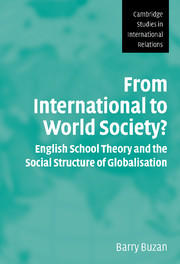 From International to World Society?
From International to World Society? Book contents
- Frontmatter
- Contents
- List of figures and tables
- Preface
- List of abbreviations
- Glossary
- Introduction
- 1 English school theory and its problems: an overview
- 2 World society in English school theory
- 3 Concepts of world society outside English school thinking
- 4 Reimagining the English school's triad
- 5 Reconstructing the pluralist–solidarist debate
- 6 The primary institutions of international society
- 7 Bringing geography back in
- 8 Conclusions: a portrait of contemporary interstate society
- List of references
- Index
- CAMBRIDGE STUDIES IN INTERNATIONAL RELATIONS
8 - Conclusions: a portrait of contemporary interstate society
Published online by Cambridge University Press: 14 January 2010
- Frontmatter
- Contents
- List of figures and tables
- Preface
- List of abbreviations
- Glossary
- Introduction
- 1 English school theory and its problems: an overview
- 2 World society in English school theory
- 3 Concepts of world society outside English school thinking
- 4 Reimagining the English school's triad
- 5 Reconstructing the pluralist–solidarist debate
- 6 The primary institutions of international society
- 7 Bringing geography back in
- 8 Conclusions: a portrait of contemporary interstate society
- List of references
- Index
- CAMBRIDGE STUDIES IN INTERNATIONAL RELATIONS
Summary
In chapter 1 I set out both my dissatisfactions with English school theory, and the reasons why I nevertheless thought it well worth pursuing. I committed myself to trying to shine some light on the important, but murky, relationship between international and world society, and to developing a structural interpretation of English school ideas, constructing them as a theory about norms rather than a normative theory. I also committed myself to using the methodological pluralism of English school theory, and its ability to look at several things at once, as a way of unpacking the problem of globalisation, and gaining more leverage on it. This agenda took me much deeper than I had originally intended, and with some help from various thinkers both inside and outside the English school, I have ended up with a rather radical revision of the classical three traditions. I hope I have also ended up with a plausible way of looking at the complex package of things that constitute the globalisation problematique.
Since misunderstandings seem to occur with frightening ease in academic debates, let me state very clearly for the record that I do not intend that this structural rewriting of English school theory should replace or override the normative version of English school thinking which I labelled Wightian in chapter 1. Wight's three traditions of debate about international relations, and the ongoing tensions between a prevailing orthodoxy and the various visions that challenge it, remains a valid and necessary understanding of English school theory.
- Type
- Chapter
- Information
- From International to World Society?English School Theory and the Social Structure of Globalisation, pp. 228 - 270Publisher: Cambridge University PressPrint publication year: 2004


